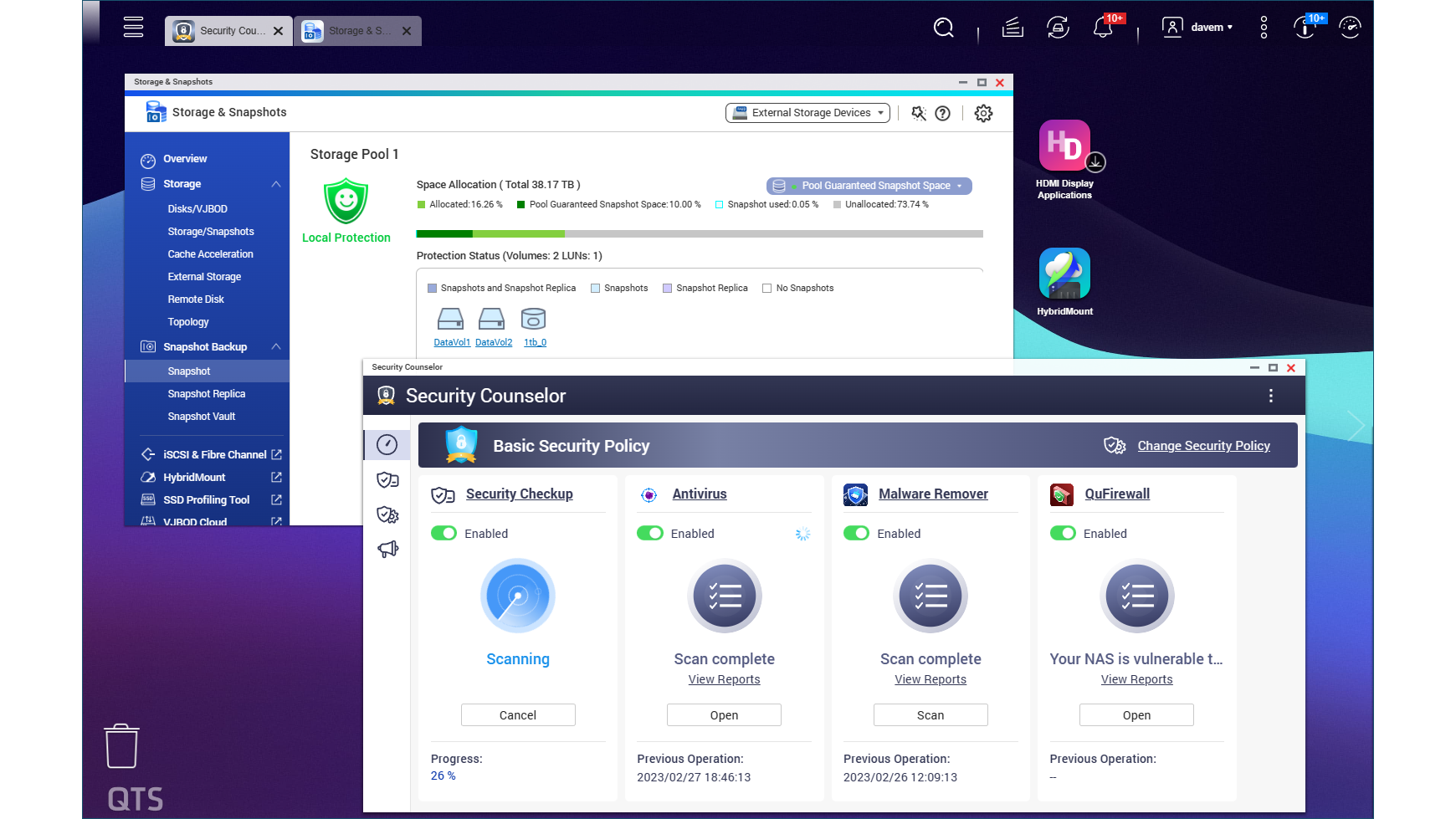Qnap TS-1655 review: A desktop storage leviathan
Qnap's mighty 16-bay NAS puts more storage on your desk than anyone else


-
+
Huge storage capacity
-
+
Reasonable value
-
+
QTS data protection features
-
-
No embedded 10GbE ports

Qnap's TS-1635 NAS appliance made a big splash when it was launched back in 2016 as this monster cube was the largest desktop model on the planet. There have been quite a few hardware updates over the ensuing years, each offering variations on processing power and network ports, but all have retained the front storage arrangement of 12 LFF and 4 SFF hot-swap drive bays.
Enter the TS-1655, which offers the same impressively high capacity but adds a range of new features. At £1,666 for a diskless model, it's also a lot better value than Qnap's expensive Intel Xeon-powered TVS-h1688X which costs around £2,785.
It's all changed in the CPU department as the TS-1655 sports a more modern 2.8GHz 8-core Intel Atom C5125. Along with two extra physical cores over the TVS-h1688X, it supports faster 2,933MHz DDR4 memory which can also be upgraded to a very usable 128GB.
The lack of an 'h' in the model name indicates Qnap is aiming the TS-1655 at those that prefer to run its more nimble QTS operating system. You can install QuTS hero if you wish, but it's more memory intensive so the appliance's base 8GB will need to be upgraded to a minimum of 16GB, and preferably 32GB, to get the best out of this OS.
Qnap TS-1655 review: Hardware features
As with its other 16-bay stablemates, the TS-1655 is very well built and comes clothed in a sturdy steel chassis and cover. The LFF and SSF bays use plastic tool-free hot-swap carriers and all can be locked with the supplied key.
At the back are a pair of embedded 2.5GbE multi-Gigabit data ports but the TS-1655 is the first in this family not to include any 10GbE ports. However, it does offer three spare PCIe slots which can be used to add extra network adapters with Qnap offering a good range of 10GbE and 25GbE cards.
Removing the lid reveals the motherboard on the right-hand side with the CPU's large heatsink partnered by a dual-fan blower module. The chassis has three more 9cms diameter fans at the back and we found the appliance to be pleasingly quiet.

The motherboard has four standard DIMM slots with one occupied by an 8GB stick. The pair of M.2 NVMe SSD slots alongside can be used to provide a high-speed cache, a fast storage pool or be linked up with Qnap's QTS QTier feature as a high-performance tier for data migration.
Qnap TS-1655 review: QTS apps
For testing, we loaded four 14TB Western Digital Red Pro HDDs and followed the web-based quick start wizard to install the latest version of QTS. It's worth noting that Qnap's storage compatibility list shows a wide range of HDDs from Western Digital, Seagate and Toshiba whereas Synology's DS3622xs+ and DS2422+ 12-bay desktop models are restricted to its own HAT5300 models.
QTS doesn't offer the same level of integral enterprise-class data protection features as QuTS hero but it can run all the same backup apps. It supports on-demand and scheduled snapshots for NAS shares and iSCSI LUNs while the slick Hybrid Backup Sync (HBS) 3 app can manage a 3-2-1 backup strategy and secure local data to cloud providers or remote NAS appliances for off-site storage.
The Hyper Data Protector (HDP) app extends protection to VMware and Hyper-V virtualised environments. It opens a dedicated web console for all backup and restore management and we found it simple to add our VMware vCenter and Hyper-V hosts, select VMs and schedule backup tasks.
The appliance can host virtual machines as the Container Station, Ubuntu Linux Station and Virtualization Station apps are all available. Data security has a high priority too, as along with the Antivirus, Malware Remover and QuFirewall apps, the Qnap's Security Counselor uses predefined scan policies to search for vulnerabilities.
Qnap TS-1655 review: 2.5GbE and 10GbE performance
For 2.5GbE performance testing, we hooked the appliance up to our Zyxel XS1930-12HP 10GbE multi-Gigabit switch and mapped a NAS share to a Dell PowerEdge T640 server running Windows Server 2019.
Speeds were on the money with Iometer reporting sequential read and write rates of 2.3Gbits/sec and 2.2Gbits/sec with our real world copies of a 25GB test file also delivering the same speeds. IP SAN speeds were very similar with a 1TB iSCSI target returning read and write rates of 2.2Gbits/sec and 2Gbits/sec.
For 10GbE testing, we installed a Broadcom dual-port 10GbE card in the appliance without any issues. For our mapped NAS share, Iometer raw read and write rates increased nicely to 9.3Gbits/sec and 9.1Gbit/sec while our large file copies improved to 4.3Gbits/sec and 4.2Gbits/sec.
IP SAN performance over 10GbE also saw a big boost with the iSCSI target delivering read and write rates of 9.3Gbits/sec and 8.9Gbit/sec. However, after increasing the pressure with a dual-10GbE MPIO link to the target, we only saw modest improvement to 14Gbits/sec and 9.5Gbits.
QTS doesn't have the ARC (adaptive read cache) and ZIL (ZFS intent log) features offered by QuTS hero so SSDs caches are worth considering if you have workloads generating random write operations. Random write speeds for our MPIO target settled at a mere 1Gbit/sec and 4,300 IOPS but after assigning a mirrored cache comprising two 480GB Kingston M.2 NVMe SSDs, these numbers improved significantly to 4.2Gbits/sec and 49,700 IOPS.
Qnap TS-1655 review: Verdict
SMBs that want the biggest desktop NAS appliance on the market need look no further than Qnap's TS-1655. Its huge storage capacity makes it ideal for a wide range of duties including backup, disaster recovery, file sharing plus surveillance recording and it's better value than Synology's 12-bay DS3622xs+.
The lack of embedded 10GbE ports counts against it but the spare PCIe slots means it can be easily upgraded if required. The SFF bays and internal M.2 NVMe SSD slots allow it to offer a complete hybrid storage solution while Qnap's QTS software delivers an impressive range of business apps and data protection services.
Qnap TS-1655 specifications
| Chassis | Desktop chassis |
| CPU | 2.8GHz 8-core Intel Atom C5125 |
| Memory | 8GB DDR4 UDIMM (max 128GB) |
| Storage | 12 x SATA LFF, 4 x SATA SFF, 2 x M.2 2280 NVMe SSD |
| RAID | (QTS) RAID0, 1, 5, 6, 10, 50, 60 |
| Expansion | 3 x PCIe Gen3 x4 |
| Network | 2 x 2.5GbE multi-Gigabit |
| Other ports | 4 x USB 3.2 Gen1 |
| Power | 550W internal PSU |
| Management | Web browser |
| Warranty | 3 year limited |
Get the ITPro daily newsletter
Sign up today and you will receive a free copy of our Future Focus 2025 report - the leading guidance on AI, cybersecurity and other IT challenges as per 700+ senior executives
Dave is an IT consultant and freelance journalist specialising in hands-on reviews of computer networking products covering all market sectors from small businesses to enterprises. Founder of Binary Testing Ltd – the UK’s premier independent network testing laboratory - Dave has over 45 years of experience in the IT industry.
Dave has produced many thousands of in-depth business networking product reviews from his lab which have been reproduced globally. Writing for ITPro and its sister title, PC Pro, he covers all areas of business IT infrastructure, including servers, storage, network security, data protection, cloud, infrastructure and services.
-
 M&S suspends online sales as 'cyber incident' continues
M&S suspends online sales as 'cyber incident' continuesNews Marks & Spencer (M&S) has informed customers that all online and app sales have been suspended as the high street retailer battles a ‘cyber incident’.
By Ross Kelly Published
-
 Westcon-Comstor unveils new managed SOC solution for Cisco partners
Westcon-Comstor unveils new managed SOC solution for Cisco partnersNews Powered by Cisco XDR, the new offering will enable partners to tap into new revenue streams, the company said
By Daniel Todd Published
-
 More than 5 million Americans just had their personal information exposed in the Yale New Haven Health data breach – and lawsuits are already rolling in
More than 5 million Americans just had their personal information exposed in the Yale New Haven Health data breach – and lawsuits are already rolling inNews A data breach at Yale New Haven Health has exposed data belonging to millions of people – and lawsuits have already been filed.
By Emma Woollacott Published